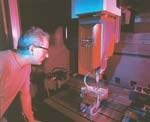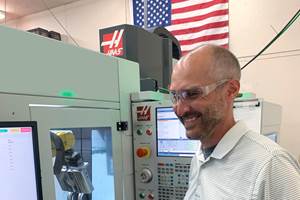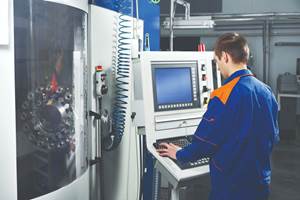Shop Owes Growth To CAD/CAM Versatility
This shop's programmer/operators, equipped with the most versatile CAD/CAM software they could choose, moved on to the tool path and cut more combinations of amazingly diverse parts, as a company confident of its ability to meet any of its customers' molding, machining or manufacturing needs.
A success story of expansion through diversification, 26-year-old Hofmann Tool Company has grown to employ more than 60 employees and, 5 years ago, moved into a new 40,000-square-foot manufacturing center. The company's capabilities include die cast dies and trim dies for customers across the automotive industry. For the commercial carpentry market, Hofmann adds stamping dies and progressive dies to its menu. Flexibility on the floor allows Hofmann to produce plastic molds for irrigation and household piping, and the company also builds ladder upsetting machines and heat shrinking machines for secondary operations and other specialized machines. Hofmann's floor plan and operator skills are at such a state-of-the-art level that the company simultaneously produces a diverse combination of parts using the whole spectrum of metalworking machines and techniques.
"Our operators are our programmers," says Chester Griffin, project manager. "Because we have so many different product lines, they need to be able to get a tool path running while they're getting the next design going." Mr. Griffin recalls that Hofmann's ability to do that began after reading a 1991 Modern Machine Shop article about Mastercam CAD/CAM software from CNC Software (Tolland, Connecticut) and purchased a seat of Level I Version 1. "Mastercam's ability to change and upgrade, and meet the challenges we had," Mr. Griffin continues, "was just the ticket for expanding our business."
In 1995 Mastercam became Hofmann's company-wide CAD/CAM software, the versatility and speed of which, according to Mr. Griffin, added 30 percent in new business the first year. "Because we do more with advanced CAM technology now, the same number of people can throughput almost a third more work."
Hofmann Tool now works with eight seats of Mastercam in 2D, 3D and Solids for mill, lathe and EDM production. The company also takes advantage of many of the add-ons that are available. A recent example includes the use of the RevQuick add-on to reverse-engineer trim dies for water pump castings for an automotive industry parts supplier. "Many auto parts are made from 2D prints—not 3D files," says Mr. Griffin, "so changes that developed over the years—modifying shapes to miss a line here, a hose there—are not able to be imported into our CAD/CAM program."
"Using RevQuick saved us the time we'd have had to spend measuring with the machine's tool and creating splines and other curves from those points, which, of course, Mastercam could have done," says Mr. Griffin. "But since the add-on imported and used the point cloud data so readily, we gained a turnaround advantage, which will help our sales as we bid on other jobs."
The pump housings measured approximately 10 inches by 8 inches by 4 inches. Programmer/operator Don Wortman aligned the work with the 4-inch dimension along the Z axis for a minimum depth of cut to machine the steel "nest," which would fixture the raw castings for trimming. He programmed a 2D roughing tool path, specifying a 2½-inch indexable carbide cutter at 15,000 rpm, 0.030 inch deep per pass with a 0.015 stepover at 300 ipm. "Mastercam's high speed machining capability saved us production time," Mr. Griffin observes, "without sacrificing the quality on which we've built Hofmann's reputation."
Mr. Wortman used the "leftover" function for a semi-finish pass with a ½ inch cutter to pick out any material in the tight corners of the nest, then ran successive "leftover" passes with ¼ inch and 1/8 inch cutters for a final finish inside and around the periphery of the nest. "The old way," Mr. Griffin says, "we'd have had to write the tool path again for each pass. ‘Leftover' takes care of that automatically."
Cutting the trim steel would complete the other half of the water pump trim die sets for each pump. The original laser scan provided the geometry for the tool path to wire the 1-inch trim steel to the periphery of the parts. The tool path was programmed to allow for a 2½ inches of material extension to accommodate the nuts and screws to attach the trim steel to the die shoe of the customer's presses. The trim dies were installed on the customer's presses adjacent to the their die-cast machines. As each part was finished in the die-casting process, it was manually flipped over into the Hofmann-machined nest, fixtured on the bed of the adjacent press. The press plunged, and the trim steel cut away the runners and overflows for a perfect profile.
Meanwhile, Hofmann programmer/operators, equipped with the most versatile CAD/CAM software they could choose, moved on to the tool path and cut more combinations of amazingly diverse parts, as a company confident of its ability to meet any of its customers' molding, machining or manufacturing needs. While Hofmann is hardly unique in its use of Mastercam, it has stretched—and continues to stretch—its capabilities by pushing the envelope. There is support for even the most entrepreneurial spirits to be limited only by the scope of their imaginations.
Related Content
5 Reasons Why Machine Shop Ownership Is Changing
Mergers, acquisitions and other ownership changes are an effect of Boomer-age shop owners retiring, but only in part. Also important: The way we think about machining has changed.
Read More5 G-Code Tips for Increasing CNC Efficiency
Optimizing G code is a low-cost way to improve CNC efficiency without sacrificing usability and safety.
Read More5 Tips for Running a Profitable Aerospace Shop
Aerospace machining is a demanding and competitive sector of manufacturing, but this shop demonstrates five ways to find aerospace success.
Read MoreUnderstanding CNC Machine Accuracy and Repeatability
Properly evaluating machine tool capability requires understanding how the both user and the builder can influence precision.
Read MoreRead Next
3 Mistakes That Cause CNC Programs to Fail
Despite enhancements to manufacturing technology, there are still issues today that can cause programs to fail. These failures can cause lost time, scrapped parts, damaged machines and even injured operators.
Read MoreThe Cut Scene: The Finer Details of Large-Format Machining
Small details and features can have an outsized impact on large parts, such as Barbco’s collapsible utility drill head.
Read MoreObscure CNC Features That Can Help (or Hurt) You
You cannot begin to take advantage of an available feature if you do not know it exists. Conversely, you will not know how to avoid CNC features that may be detrimental to your process.
Read More



























